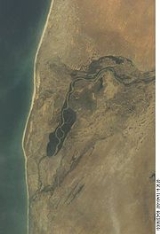
Agriculture in Mauritania
Encyclopedia
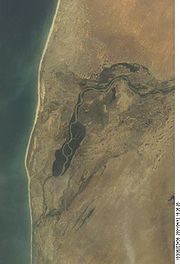
Sahara
The Sahara is the world's second largest desert, after Antarctica. At over , it covers most of Northern Africa, making it almost as large as Europe or the United States. The Sahara stretches from the Red Sea, including parts of the Mediterranean coasts, to the outskirts of the Atlantic Ocean...
n zones, Mauritania
Mauritania
Mauritania is a country in the Maghreb and West Africa. It is bordered by the Atlantic Ocean in the west, by Western Sahara in the north, by Algeria in the northeast, by Mali in the east and southeast, and by Senegal in the southwest...
has one of the poorest agricultural bases in West Africa. Most important to the rural economy has been the livestock
Livestock
Livestock refers to one or more domesticated animals raised in an agricultural setting to produce commodities such as food, fiber and labor. The term "livestock" as used in this article does not include poultry or farmed fish; however the inclusion of these, especially poultry, within the meaning...
subsector. Between 1975 and 1980, herding
Herding
Herding is the act of bringing individual animals together into a group , maintaining the group and moving the group from place to place—or any combination of those. While the layperson uses the term "herding", most individuals involved in the process term it mustering, "working stock" or...
engaged up to 70 percent of the population, and sedentary farmers constituted about 20 percent of the population. The vast majority of the population lived in the southern one-third of the country, where rainfall levels were high enough to sustain cattle herding. Farming was restricted to the narrow band along the Senegal River
Sénégal River
The Sénégal River is a long river in West Africa that forms the border between Senegal and Mauritania.The Sénégal's headwaters are the Semefé and Bafing rivers which both originate in Guinea; they form a small part of the Guinean-Malian border before coming together at Bafoulabé in Mali...
where rainfall of up to 600 millimeters per year and annual river flooding sustained crop production as well as large cattle herds. In the dry northern two-thirds of the country, herding was limited to widely scattered pastoral groups that raised camel
Camel
A camel is an even-toed ungulate within the genus Camelus, bearing distinctive fatty deposits known as humps on its back. There are two species of camels: the dromedary or Arabian camel has a single hump, and the bactrian has two humps. Dromedaries are native to the dry desert areas of West Asia,...
s, sheep, and goat
Goat
The domestic goat is a subspecies of goat domesticated from the wild goat of southwest Asia and Eastern Europe. The goat is a member of the Bovidae family and is closely related to the sheep as both are in the goat-antelope subfamily Caprinae. There are over three hundred distinct breeds of...
s, and farming was restricted to date palms and minuscule plots around oases.
A major reason for Mauritania's economic stagnation
Economic stagnation
Economic stagnation or economic immobilism, often called simply stagnation or immobilism, is a prolonged period of slow economic growth , usually accompanied by high unemployment. Under some definitions, "slow" means significantly slower than potential growth as estimated by experts in macroeconomics...
since the mid-1970s has been the decline of its rural sector. Government planners neglected both herding and farming until the 1980s, concentrating instead on development in the modern sector. The rural sector was severely affected by droughts from 1968 through 1973 and from 1983 through 1985, and it has suffered from sporadic dry spells in other years. In the 1960s, livestock and crop production together provided 35 to 45 percent of GDP (at constant 1982 prices). From 1970 to 1986, their contribution to GDP (at constant 1982 prices) averaged 28 percent, with herding accounting for about 20 percent of this figure and with crop production falling to as low as 3 to 5 percent in the worst drought years. Millet and sorghum production reached 10,000 and 75,000 tons, respectively, in 1999. Other crop production in 1999 included paddy rice, 102,000 tons; and corn, 8,000 tons. Date production was 22,000 tons in 1999.
The Mauritanian government is facilitating agricultural development of the Senegal River valley. The OMVS began in 1981 to build a dam at Manantali
Manantali
Manantali is a town on the Bafing River in the Kayes Region of south-western Mali. East of the town is Lake Manantali and its dam....
, in Mali, for purposes of river transport, irrigation, and hydroelectric power. Mauritania initiated an irrigation and development scheme in 1975 for the Gorgol River
Gorgol River
The Gorgol River is a river of southern Mauritania. Located in the south flowing through the Gorgol valley, it is a tributary of the Senegal River.The river basin plays an important in role in Mauritanian economy facilated by investment in the 1970s...
valley where the dam would increase arable land by over 3,600 ha (9,000 acres). This project was to be followed by other dams that together would add 30,000 ha (74,100 acres) for food production . Another OMVS project, begun in 1981, was designed to prevent salt water from entering the fertile Senegal River delta. Between 1989 and 1991, the Mauritanian government sought to rationalize agricultural production.
Herding
Historically, cattle herding was Mauritania's most important economic activity. In the 1980s, with a cattle-to-people ratio of three to one, the highest in West Africa. Herding provided subsistence for up to 70 percent of the country's people. Herding has been dramatically affected by chronic drought and the attendant rapid advance of the desertDesert
A desert is a landscape or region that receives an extremely low amount of precipitation, less than enough to support growth of most plants. Most deserts have an average annual precipitation of less than...
. These events have forced shifts in patterns of movement, herd composition and ownership, and increased pressures on lands also occupied by sedentary farmers in the south.
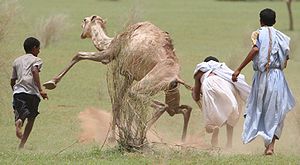
The drought also caused shifts in the herding of camels (traditionally located in the drier north) and of sheep and goats (held by groups all across Mauritania). These changes were less dramatic than those for cattle, however, because camels, sheep, and goats are more resistant to drought. Although decreases in sheep, goat, and camel herd size in drought years could be significant, recovery was more rapid and sustained. In the years following the 1968-73 drought, camel, sheep, and goat
Goat
The domestic goat is a subspecies of goat domesticated from the wild goat of southwest Asia and Eastern Europe. The goat is a member of the Bovidae family and is closely related to the sheep as both are in the goat-antelope subfamily Caprinae. There are over three hundred distinct breeds of...
herd sizes increased to predrought levels or higher. The same pattern seemed evident during the 1983-85 drought and the recovery years of the late 1980s. Indeed, the overall size of camel, sheep, and goat herds may have risen since the 1960s, as these hardier animals have moved into areas abandoned by cattle herds. This pattern seems to have been particularly true for the camel herds.
In the 1960s, cattle herds in Mauritania were composed of two basic types: the lighter, short-horned zebu, or "maure
Maure
A Maure, since the 11th century, is the symbol of an African head. The term has Phoenician and Greek origins; see Moors.- U Moru :The main symbol in the coat of arms in Corsica is U Moru, Corsican for "The Moor", originally a female Moor blindfolded and wearing a necklace made of beads...
," which made up perhaps 85 percent of the national herd; and the heavier, long-horned zebu, or "peul." The smaller zebu
Zebu
Zebu , sometimes known as humped cattle, indicus cattle, Cebu or Brahmin cattle are a type of domestic cattle originating in South Asia, particularly the Indian subcontinent. They are characterised by a fatty hump on their shoulders, drooping ears and a large dewlap...
ranged farther north and were owned by nomadic herders. The larger zebu stayed closer to the better watered riverine areas and were owned by sedentary groups who practiced agriculture in addition to livestock raising.
Although traditional herding patterns persist, considerable changes have taken place. Since the 1968-73 drought, precipitation has been below average. Between 1973 and 1984, as the 150-millimeter isohyet line moved south, livestock often were forced to stay year-round in dry season grazing areas nearer the Senegal River and across the border in Senegal
Senegal
Senegal , officially the Republic of Senegal , is a country in western Africa. It owes its name to the Sénégal River that borders it to the east and north...
and Mali
Mali
Mali , officially the Republic of Mali , is a landlocked country in Western Africa. Mali borders Algeria on the north, Niger on the east, Burkina Faso and the Côte d'Ivoire on the south, Guinea on the south-west, and Senegal and Mauritania on the west. Its size is just over 1,240,000 km² with...
. Thus, the herd populations were compressed into a smaller area, increasing pressure on land resources and heightening competition among herding groups and between herders and sedentary farmers. Overgrazing in increasingly crowded areas and the cutting of trees and shrubs for firewood and fodder (particularly for sheep and goats) contributed to accelerating desertification
Desertification
Desertification is the degradation of land in drylands. Caused by a variety of factors, such as climate change and human activities, desertification is one of the most significant global environmental problems.-Definitions:...
and posed a threat to crop production.
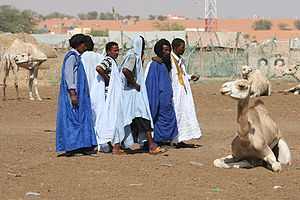
The Ministry of Rural Development of Mauritania was responsible for livestock and natural resource conservation. The ministry's National Livestock Department (Direction Nationale d'Elevage - DNE) was responsible for field services and for the annual rinderpest vaccination campaign. Headquartered in Nouakchott
Nouakchott
-Government:The town was first divided into districts in 1973. First it was divided into four. From 1986, the city has been split into nine districts.* Arafat* Dar Naim* El Mina* Ksar* Riad* Sebkha* Tevragh-Zeina* Teyarett* Toujounine...
, in the mid-1980s the DNE operated eleven field centers in regional capitals and nineteen veterinary field stations, mostly located in the southern third of the country. Used principally in the annual vaccination campaigns, these field stations offered few other veterinary and extension services. The ministry also operated the National School for Training and Rural Extension (Ecole Nationale de Formation et Vulgarisation Rurale—ENFVR) at Kaédi
Kaédi
Kaédi is a city of over 60,000 people and is the largest city and administrative center of the Gorgol region of Southern Mauritania. The city is located 16.150 degrees latitude and -13.500 degrees longitude, and is approximately 435 km from Mauritania's capital, Nouakchott.- Overview :The...
, which since 1968 has trained veterinary field staff.
In 1981 the government established an autonomous state marketing enterprise, the Mauritanian Livestock Marketing Company (Société Mauritanienne de la Commercialisation du Betail—SOMECOB). This agency had an official, but unenforceable, monopoly over livestock exports and the authority to intervene in market operations to stabilize domestic livestock prices. SOMECOB was also responsible for the Kaédi Abattoir, constructed in 1975 as an export slaughterhouse. By 1986 it functioned for local municipal consumption only, far below capacity, and SOMECOB's exports were negligible. Private exports of live cattle took place without obstruction from SOMECOB. This trade consisted mostly of unrecorded movements into Senegal, Mali, and countries farther south. In the mid-1980s, the most important market for Mauritanian cattle was domestic, centered on Nouakchott, Nouadhibou
Nouadhibou
Nouadhibou is the second largest city in Mauritania and serves as a major commercial centre. The city itself has about 75,000 inhabitants expanding to over 90,000 in the larger metropolitan area. It is situated on a 40-mile peninsula or headland called Ras Nouadhibou, Cap Blanc, or Cabo Blanco, of...
, and the mining centers
Farming
Although it is a large country, most of Mauritania is desert. In the late 1980s, arable land was scarce, and, except for some oases, crop production was limited to a narrow band along the southern borders with Senegal and Mali. Farmers practiced four types of agriculture: rain-fed dryland cropping, called dieri; floodFlood
A flood is an overflow of an expanse of water that submerges land. The EU Floods directive defines a flood as a temporary covering by water of land not normally covered by water...
recession cropping along the Senegal River and its seasonal tributaries, called oualo; oasis cultivation, the least important; and modern irrigated agriculture.
The most important methods, dieri
Dieri
The Dieri is an Indigenous Australian group and language from the South Australian desert—specifically Cooper and Leigh Creek, Lake Howitt, and Lake Hope, Lake Gregory and Clayton River and low country north of Mount Freeling.-Alternate names:DiariDiyeri...
and oualo, were entirely dependent on limited and erratic rainfall and on the annual flooding of the Senegal River and its only perennial tributary in Mauritania, the Gorgol River
Gorgol River
The Gorgol River is a river of southern Mauritania. Located in the south flowing through the Gorgol valley, it is a tributary of the Senegal River.The river basin plays an important in role in Mauritanian economy facilated by investment in the 1970s...
. Dieri cultivation occurred during the rainy season, from June–July to September–October, in areas receiving sufficient precipitation
Precipitation (meteorology)
In meteorology, precipitation In meteorology, precipitation In meteorology, precipitation (also known as one of the classes of hydrometeors, which are atmospheric water phenomena is any product of the condensation of atmospheric water vapor that falls under gravity. The main forms of precipitation...
(400 to 450 millimeters annually) to grow millet and peas. Oualo plantings occurred during the cold dry season from November to March, to take advantage of ground moisture as the flood waters of the Senegal and Gorgol rivers receded. Sorghum was the major crop for this season. Oasis cultivation drew its water from subterranean sources and so was not dependent on rains. Indeed, areas where oases were located might not experience any significant rainfall for years. Modern irrigated agriculture was only partially dependent on annual rainfall. It depended primarily on dams to retain water from the annual rise on the rivers resulting from rains falling upriver. For the Senegal River, these rains fell principally in the headwaters in eastern Mali and Guinea.
The two major drought
Drought
A drought is an extended period of months or years when a region notes a deficiency in its water supply. Generally, this occurs when a region receives consistently below average precipitation. It can have a substantial impact on the ecosystem and agriculture of the affected region...
s of the African Sahel were prolonged in Mauritania by intermittent dry spells. The result was a serious decline in overall agricultural production. In the 1960s, Mauritania had produced about one-half of its grain needs. By the 1983-85 period, grain harvests had fallen to a level that met only about 3 to 8 percent of the country's grain needs. The cereal deficits have been filled through a combination of commercial imports and international food aid, of which the United States has been the principal donor. During the most serious drought years, from 1983 to 1985, food aid accounted for over 61 percent of Mauritania's available supply of grain, commercial imports of rice by the government covered approximately 20 percent, and imports of flour by private traders provided another 13 percent . Local production was able to cover only 5 percent of need. In the following three years, local production recovered sufficiently to meet about one-third of the annual grain need, estimated in 1986 at 260,000 tons. In that year, local production covered 35 percent of need, government imports supplied 30 percent, and food aid met 35 percent.
Although accurate data were lacking, production of all grains in the recovery years from 1985 to 1987 rose to between 68,000 and 120,000 tons, a large increase over the record low of approximately 20,000 tons in 1984 (see fig. 8). Thus, gross production between 1985 and 1987 attained levels not matched since the mid-1960s. Rising population in the interim meant that, despite this significant recovery, the country remained dependent on imported grains to satisfy its needs
Cropping
Millet and sorghum were Mauritania's principal crops, followed by rice and corn. Before the 1980s, millet and sorghum accounted for 70 to 80 percent or more of total grain production. Rice production in the 1970s averaged 5 to 10 percent, and corn made up 10 to 25 percent. In the 1980s, rice production grew in importance, as national planning emphasized irrigated agriculture (which favored rice) and a change in dietary habits. Millet and sorghum production reached 10,000 and 75,000 tons, respectively, in 1999. Other crop production in 1999 included paddy rice, 102,000 tons; and corn, 8,000 tons. Date production was 22,000 tons in 1999.A few other crops were cultivated. Around 10,000 to 15,000 tons of dates were produced annually in the country's oases, mostly for local consumption. During the 1960s, the traditional production of gum arabic (see Glossary) rose to some 5,000 tons a year. By the 1980s, however, production of gum arabic had disappeared. The ill-considered cutting of trees to increase short-term production combined with drought to destroy virtually all of Mauritania's gum-producing acacia
Acacia
Acacia is a genus of shrubs and trees belonging to the subfamily Mimosoideae of the family Fabaceae, first described in Africa by the Swedish botanist Carl Linnaeus in 1773. Many non-Australian species tend to be thorny, whereas the majority of Australian acacias are not...
trees.
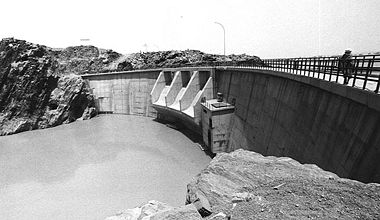
In the 1980s, the government put increased emphasis on developing the rural sector. Government planning strategy under the 1985-88 Economic Recovery Program placed the highest priority on rural development (35 percent of planned investments). Particular attention was to be paid to upgrading existing land and developing new irrigated farming and flood recession agriculture. There were also plans involving Mauritania, Mali, and Senegal to integrate rural development and water and flood control through the Senegal River Development Office (Organisation pour la Mise en Valeur du Fleuve Sénégal—OMVS) as the massive Diama and Manantali dams became fully operational (see Relations with Other African States, ch. 4
Land tenure
The system of land tenure was in transition in the 1980s. Factors contributing to this transition included government abolition of centuries-old slaverySlavery
Slavery is a system under which people are treated as property to be bought and sold, and are forced to work. Slaves can be held against their will from the time of their capture, purchase or birth, and deprived of the right to leave, to refuse to work, or to demand compensation...
practices involving tribal and ethnic relations between various herding and sedentary communities; government development policies, particularly with regard to land reform and large-scale irrigation schemes; and tremendous shifts in land settlement and herding patterns because of drought.
Historically, landownership and range management were based on tribal relations and ethnic settlement patterns. Rangeland for herding was controlled through tribal ownership of wells; around oases, slave groups worked cultivable plots, although traditional noble clans held ownership of the land. In more southerly settled agricultural areas, ownership varied from region to region and village to village, depending on ethnic settlement patterns. Landownership might be vested in the clan or village chief as representative of the group and land distributed in perpetuity to family units having usufruct. Elsewhere, traditional nobilities
Nobility
Nobility is a social class which possesses more acknowledged privileges or eminence than members of most other classes in a society, membership therein typically being hereditary. The privileges associated with nobility may constitute substantial advantages over or relative to non-nobles, or may be...
might hold ownership of lands worked by formerly enslaved groups, who held traditional usufruct. Although a village chief could not sell land belonging to the clan (which would alienate family groups from the land), traditional noble clans could more easily sell property and effectively displace or disinherit slave groups. By the late 1980s, it was not known to what extent the formal abolition of slavery had affected traditional land relationships among noble and former slave groups. Also unknown was the impact of the government's stated policy of giving priority to former slave groups when lands that might be claimed under eminent domain were redistributed.
Of potentially far greater importance in land tenancy was the 1983 Land Reform Act
1983 Land Reform Act
The 1983 Land Reform Act was an act of Mauritanian law dealing with land tenure in Mauritania.The underlying first cause of the act was the state's inherent and overriding interest in land development...
. The underlying first cause of the act was the state's inherent and overriding interest in land development. According to the act, the government could grant title for parcels of undeveloped land—which apparently included fallow land—to whoever pledged to improve it and at the same time possessed requisite resources. Although the economic necessity of the act was beyond question, the social costs of appropriating valuable Senegal River Basin land hypothetically controlled by blacks and redistributing it to wealthy Maures from farther north could prove unacceptable. It was evident, however, that the situation was in considerable flux.
Large-scale government irrigation projects and plans for integrated development based on regional water management created another set of variables for traditional patterns of land use and ownership. Groups located in areas behind dams or in areas to be either permanently flooded or deprived of annual floods with increased control over flow levels in the Senegal River were undergoing a process of controlled resettlement. The formation of cooperative production groups that were to be settled on the land—often on a first-come, first-served basis—was essential to project implementation
State regulation
In 1986 the government agencies involved in agricultural production, marketing, and food distribution were SONADER, CSA, and SONIMEX. Created in 1975, SONADER was a public agency under the control of the Ministry of Rural Development. Its general responsibilities focused on planning rural agricultural programs, including building and operating irrigation projects, training farmers in new techniques required for improved irrigationIrrigation
Irrigation may be defined as the science of artificial application of water to the land or soil. It is used to assist in the growing of agricultural crops, maintenance of landscapes, and revegetation of disturbed soils in dry areas and during periods of inadequate rainfall...
cropping, and providing credit and such inputs as fertilizers and pumping equipment. Organized in 1982 from two other agencies, CSA became responsible for stabilizing grain prices, maintaining a security food stock through market intervention, monitoring production and food deficits, and distributing food aid. SONIMEX began operations in 1966 as a government-controlled joint venture. The company held a monopoly on the imports of basic commodities (principally rice
Rice
Rice is the seed of the monocot plants Oryza sativa or Oryza glaberrima . As a cereal grain, it is the most important staple food for a large part of the world's human population, especially in East Asia, Southeast Asia, South Asia, the Middle East, and the West Indies...
, tea
Tea
Tea is an aromatic beverage prepared by adding cured leaves of the Camellia sinensis plant to hot water. The term also refers to the plant itself. After water, tea is the most widely consumed beverage in the world...
, sugar
Sugar
Sugar is a class of edible crystalline carbohydrates, mainly sucrose, lactose, and fructose, characterized by a sweet flavor.Sucrose in its refined form primarily comes from sugar cane and sugar beet...
, and tomato paste), which it resold to private interests for the retail trade. The private sector's role in cereal imports was legally restricted to wheat
Wheat
Wheat is a cereal grain, originally from the Levant region of the Near East, but now cultivated worldwide. In 2007 world production of wheat was 607 million tons, making it the third most-produced cereal after maize and rice...
and flour
Flour
Flour is a powder which is made by grinding cereal grains, other seeds or roots . It is the main ingredient of bread, which is a staple food for many cultures, making the availability of adequate supplies of flour a major economic and political issue at various times throughout history...
. Numerous private traders in the marketing chain, however, were not covered (or were covered only partially) by CSA and SONIMEX. There were no precise data on the extent of domestic production marketed by private traders compared with CSA or on the extent of the grain trade across the Senegal River that was outside the control of SONIMEX.

